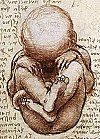
Back Puberteit Afrikaans Pubertät ALS بلوغ (إنسان) Arabic Pubertá AST Yetkinlik dövrü Azerbaijani Pubertät BAR Палавое выспяванне Byelorussian Balèg BEW Пубертет Bulgarian বয়ঃসন্ধি Bengali/Bangla
This article about biology may be excessively human-centric. (November 2024) |
| Part of a series on |
| Human growth and development |
|---|
 |
| Stages |
| Biological milestones |
| Development and psychology |
Puberty is the process of physical changes through which a child's body matures into an adult body capable of sexual reproduction. It is initiated by hormonal signals from the brain to the gonads: the ovaries in a female, the testicles in a male. In response to the signals, the gonads produce hormones that stimulate libido and the growth, function, and transformation of the brain, bones, muscle, blood, skin, hair, breasts, and sex organs. Physical growth—height and weight—accelerates in the first half of puberty and is completed when an adult body has been developed. Before puberty, the external sex organs, known as primary sexual characteristics, are sex characteristics that distinguish males and females. Puberty leads to sexual dimorphism through the development of the secondary sex characteristics, which further distinguish the sexes.
On average, females begin puberty at age 10½ and complete puberty at ages 15-17; males begin at ages 11½-12 and complete puberty at ages 16-17.[1][2][3] The major landmark of puberty for females is menarche, the onset of menstruation, which occurs on average around age 12½.[2] For males, first ejaculation, spermarche, occurs on average at age 13.[4] In the 21st century, the average age at which children, especially females, reach specific markers of puberty is lower compared to the 19th century, when it was 15 for females and 17 for males (with age at first periods for females and voice-breaks for males being used as examples).[5] This can be due to any number of factors, including improved nutrition resulting in rapid body growth, increased weight and fat deposition,[6] or exposure to endocrine disruptors such as xenoestrogens, which can at times be due to food consumption or other environmental factors.[7][8] However, more modern archeological research suggests that the rate of puberty as it occurs now is the intended way. Growth spurts began at around 10-12, but markers of later stages of puberty such as menarche had delays that correlated with severe environmental conditions such as poverty, poor nutrition, air and pollution.[9][10][11] Puberty that starts earlier than usual is known as precocious puberty, and puberty which starts later than usual is known as delayed puberty.
Notable among the morphologic changes in size, shape, composition, and functioning of the pubertal body, is the development of secondary sex characteristics, the "filling in" of the child's body; from girl to woman, from boy to man. Derived from the Latin puberatum (age of maturity), the word puberty describes the physical changes to sexual maturation, not the psychosocial and cultural maturation denoted by the term adolescent development in Western culture, wherein adolescence is the period of mental transition from childhood to adulthood, which overlaps much of the body's period of puberty.[12]
- ^ Kail RV, Cavanaugh JC (2010). Human Development: A Lifespan View (5th ed.). Cengage Learning. p. 296. ISBN 978-0-495-60037-4.
- ^ a b Schuiling (2016). Women's Gynecologic Health. Jones & Bartlett Learning. p. 22. ISBN 978-1-284-12501-6.
The changes that occur during puberty usually happen in an ordered sequence, beginning with thelarche (breast development) at around age 10 or 11, followed by adrenarche (growth of pubic hair due to androgen stimulation), peak height velocity, and finally menarche (the onset of menses), which usually occurs around age 12 or 13.
- ^ Phillips DC (2014). Encyclopedia of Educational Theory and Philosophy. SAGE Publications. pp. 18–19. ISBN 978-1-4833-6475-9.
On average, the onset of puberty is about 18 months earlier for girls (usually starting around the age of 10 or 11 and lasting until they are 15 to 17) than for boys (who usually begin puberty at about the age of 11 to 12 and complete it by the age of 16 to 17, on average).
- ^ Scannapieco M, Connell-Carrick K (2005). Understanding Child Maltreatment: An Ecological and Developmental Perspective. Oxford University Press. p. 195. ISBN 978-0-19-803563-3.
- ^ Alleyne R (2010-06-13). "Girls now reaching puberty before 10—a year sooner than 20 years ago". The Daily Telegraph. London. Archived from the original on 2010-06-14.
- ^ Guillette EA, Conard C, Lares F, Aguilar MG, McLachlan J, Guillette LJ (March 2006). "Altered breast development in young girls from an agricultural environment". Environ. Health Perspect. 114 (3): 471–5. doi:10.1289/ehp.8280. PMC 1392245. PMID 16507474.
- ^ Buck Louis GM, Gray LE, Marcus M, Ojeda SR, Pescovitz OH, Witchel SF, et al. (February 2008). "Environmental factors and puberty timing: expert panel research needs". Pediatrics. 121 (Suppl 3): S192–207. doi:10.1542/peds.1813E. PMID 18245512.
- ^ Mouritsen A, Aksglaede L, Sørensen K, Mogensen SS, Leffers H, Main KM, et al. (April 2010). "Hypothesis: exposure to endocrine-disrupting chemicals may interfere with timing of puberty". Int. J. Androl. 33 (2): 346–59. doi:10.1111/j.1365-2605.2010.01051.x. PMID 20487042.
- ^ Lewis M (2020-07-13). "Children aren't starting puberty younger, medieval skeletons reveal". University of Reading.
- ^ Lewis M, Shapland F, Watts R (2016). "On the threshold of adulthood: A new approach for the use of maturation indicators to assess puberty in adolescents from medieval England" (PDF). American Journal of Human Biology. 28 (1): 48–56. doi:10.1002/ajhb.22761. PMID 26238500. S2CID 26111310.
- ^ Papadimitriou A (2016). "The Evolution of the Age at Menarche from Prehistorical to Modern Times". Journal of Pediatric and Adolescent Gynecology. 29 (6): 527–530. doi:10.1016/j.jpag.2015.12.002. PMID 26703478.
- ^ The Oxford Dictionary of English Etymology, C. T. Onions ed. Oxford University Press, 1996, p. 720.